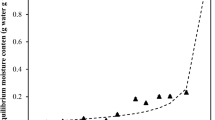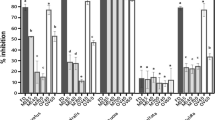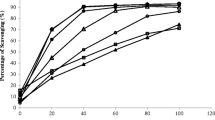Abstract
Seaweeds (Kappaphycus alvarezii and Sargassum duplicatum) are potentially rich sources of bioactive compounds and functional constituents that are used in food applications. Sun, oven, vacuum, and freeze-drying techniques are commonly used seaweed drying techniques and could be classified as cheap (sun and oven) and expensive (vacuum and freeze) drying techniques based on ovens’ market price. Therefore, the study was designed to investigate the effect of cheap (sun and oven) and expensive (vacuum and freeze) drying techniques based on color and antioxidant potential of K. alvarezii and S. duplicatum using phenolic and antioxidant assays. Principal component analysis (PCA) and hierarchical cluster analysis (HCA) were employed to discriminate the drying techniques by instrumental color analysis. The results revealed that oven-dried seaweed extracts exhibited higher levels of phenolic (0.30 to 0.36 mg GAE g−1) and antioxidant potential (3.59 to 79.68%). PCA and HCA discriminated the drying techniques into two well-defined groups/clusters I (oven, vacuum, and freeze-drying) and II (sun drying) and revealed higher ΔE values of sun-dried seaweed samples, which was interpreted as color was preserved using drying techniques of cluster I. Overall, oven, vacuum, and freeze-drying techniques reported similarities in color characteristics and could be an alternate drying technique to preserve the color of seaweed cultivars. Therefore, oven drying technique is recommended due to low cost (compared with vacuum and freeze-drying) and an affordable alternative to sun drying, the preferred technique in fishing communities of low-and-middle-income countries, for the development of seaweed-enriched functional foods.



Similar content being viewed by others
References
Adiletta G, Russo P, Senadeera W, Di Matteo M (2016) Drying characteristics and quality of grape under physical pretreatment. J Food Eng 172:9–18
Badmus UO, Taggart MA, Boyd KG (2019) The effect of different drying methods on certain nutritionally important chemical constituents in edible brown seaweeds. J Appl Phycol. https://doi.org/10.1007/s10811-019-01846-1
Chakraborty K, Maneesh A, Makkar F (2017) Antioxidant activity of brown seaweeds. J Aquat Food Prod Technol 26:406–419
Charles AL, Alamsjah MA (2019) Application of chemometric techniques: an innovative approach to discriminate two seaweed cultivars by physico-functional properties. Food Chem 289:269–277
Cruces E, Rojas-Lillo Y, Ramirez-Kushel E, Atala E, López-Alarcón C, Lissi E, Gómez I (2016) Comparison of different techniques for the preservation and extraction of phlorotannins in the kelp Lessonia spicata (Phaeophyceae): assays of DPPH, ORAC-PGR, and ORAC-FL as testing methods. J Appl Phycol 28:573–580
de Faria GSM, Hayashi L, Monteiro AR (2014) Effect of drying temperature on carrageenan yield and quality of Kappaphycus alvarezii (Rhodophyta, Solieriaceae) cultivated in Brazil. J Appl Phycol 26:917–922
Granato D, Santos JS, Escher GB, Ferreira BL, Maggio RM (2018) Use of principal component analysis (PCA) and hierarchical cluster analysis (HCA) for multivariate association between bioactive compounds and functional properties in foods: a critical perspective. Trends Food Sci Technol 72:83–90
Hamid SS, Wakayama M, Soga T, Tomita M (2018) Drying and extraction effects on three edible brown seaweeds for metabolomics. J Appl Phycol 30:3335–3350
Ling ALM, Yasir S, Matanjun P, Abu Bakar MF (2015) Effect of different drying techniques on the phytochemical content and antioxidant activity of Kappaphycus alvarezii. J Appl Phycol 27:1717–1723
Manivannan K, Karthikai Devi G, Anantharaman P, Balasubramanian T (2011) Antimicrobial potential of selected brown seaweeds from Vedalai coastal waters, Gulf of Mannar. Asian Pac J Trop Biomed 1:114–120
Mphahlele RR, Fawole OA, Makunga NP, Opara UL (2016) Effect of drying on the bioactive compounds, antioxidant, antibacterial and antityrosinase activities of pomegranate peel. BMC Complement Altern Med 16:143–143
Neoh YY, Matanjun P, Lee JS (2016) Comparative study of drying methods on chemical constituents of Malaysian red seaweed. Dry Technol 34:1745–1751
Norra I, Aminah A, Suri R (2016) Effects of drying methods, solvent extraction and particle size of Malaysian brown seaweed, Sargassum sp. on the total phenolic and free radical scavenging activity. Int Food Res J 23:1558
Orphanides A, Goulas V, Gekas V (2013) Effect of drying method on the phenolic content and antioxidant capacity of spearmint. Czech J Food Sci 31:509–513
Park K-Y, Kwon DY, Lee KW, Park S (2018) Korean functional foods: composition, processing and health benefits. CRC Press, Boca Raton 564 p
Roshanak S, Rahimmalek M, Goli SA (2016) Evaluation of seven different drying treatments in respect to total flavonoid, phenolic, vitamin C content, chlorophyll, antioxidant activity and color of green tea (Camellia sinensis or C. assamica) leaves. J Food Sci Technol 53:721–729
Sabeena Farvin KH, Jacobsen C (2013) Phenolic compounds and antioxidant activities of selected species of seaweeds from Danish coast. Food Chem 138:1670–1681
Sappati PK, Nayak B, VanWalsum GP, Mulrey OT (2019) Combined effects of seasonal variation and drying methods on the physicochemical properties and antioxidant activity of sugar kelp (Saccharina latissima). J Appl Phycol 31:1311–1332
Sarkar MS, Kamal M, Hasan M, Hossain M, Shikha F, Rasul M (2017) Manufacture of different value added seaweed products and their acceptance to consumers. Asian J Med Biol Res 2:639–645
Silva AFR, Abreu H, Silva AMS, Cardoso SM (2019) Effect of oven-drying on the recovery of valuable compounds from Ulva rigida, Gracilaria sp. and Fucus vesiculosus. Mar Drugs 17:E90
Sridhar K, Charles AL (2018) Application of multivariate statistical techniques to assess the phenolic compounds and the in vitro antioxidant activity of commercial grape cultivars. Aust J Chem 32:e3073
Stévant P, Indergård E, Ólafsdóttir A, Marfaing H, Larssen WE, Fleurence J, Roleda MY, Rustad T, Slizyte R, Nordtvedt TS (2018) Effects of drying on the nutrient content and physico-chemical and sensory characteristics of the edible kelp Saccharina latissima. J Appl Phycol 30:2587–2599
Uribe E, Vega-Gálvez A, García V, Pastén A, López J, Goñi G (2019) Effect of different drying methods on phytochemical content and amino acid and fatty acid profiles of the green seaweed, Ulva spp. J Appl Phycol 31:1967–1979
Vairappan CS, Razalie R, Elias UM, Ramachandram T (2014) Effects of improved post-harvest handling on the chemical constituents and quality of carrageenan in red alga, Kappaphycus alvarezii Doty. J Appl Phycol 26:909–916
Wong K, Cheung PC (2001) Influence of drying treatment on three Sargassum species. J Appl Phycol 13:43–50
Wong K, Chikeung Cheung P (2001) Influence of drying treatment on three Sargassum species 2. Protein extractability, in vitro protein digestibility and amino acid profile of protein concentrates. J Appl Phycol 13:51–58
Younis M, Abdelkarim D, Zein El-Abdein A (2018) Kinetics and mathematical modeling of infrared thin-layer drying of garlic slices. Saudi J Biol Sci 25:332–338
Zamroni A, Yamao M (2011) Coastal resource management: fishermen’s perceptions of seaweed farming in Indonesia
Zhang Z, Murtagh F, Van Poucke S, Lin S, Lan P (2017) Hierarchical cluster analysis in clinical research with heterogeneous study population: highlighting its visualization with R. Ann Translat Med 5 (4):75–75
Funding
This study was financially supported by the Universitas Airlangga Tahir Professorship Endowment, Indonesia.
Author information
Authors and Affiliations
Corresponding authors
Ethics declarations
Conflict of interest
The authors declare that they have no conflict of interest
Additional information
Publisher’s note
Springer Nature remains neutral with regard to jurisdictional claims in published maps and institutional affiliations.
Electronic supplementary material
ESM 1
(DOCX 12705 kb)
Rights and permissions
About this article
Cite this article
Charles, A.L., Sridhar, K. & Alamsjah, M.A. Effect of drying techniques on color and bioactive potential of two commercial edible Indonesian seaweed cultivars. J Appl Phycol 32, 563–572 (2020). https://doi.org/10.1007/s10811-019-01916-4
Received:
Revised:
Accepted:
Published:
Issue Date:
DOI: https://doi.org/10.1007/s10811-019-01916-4




